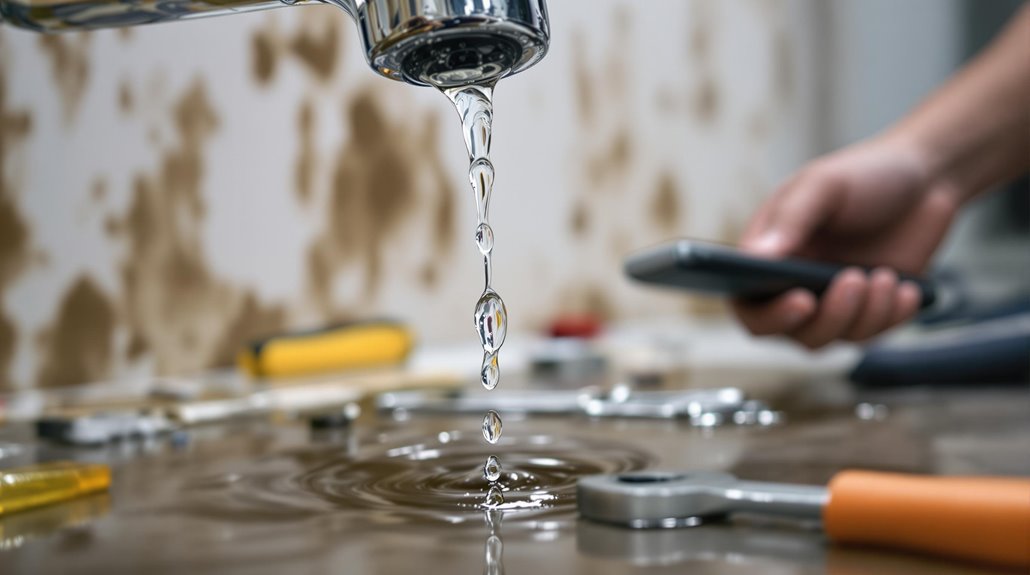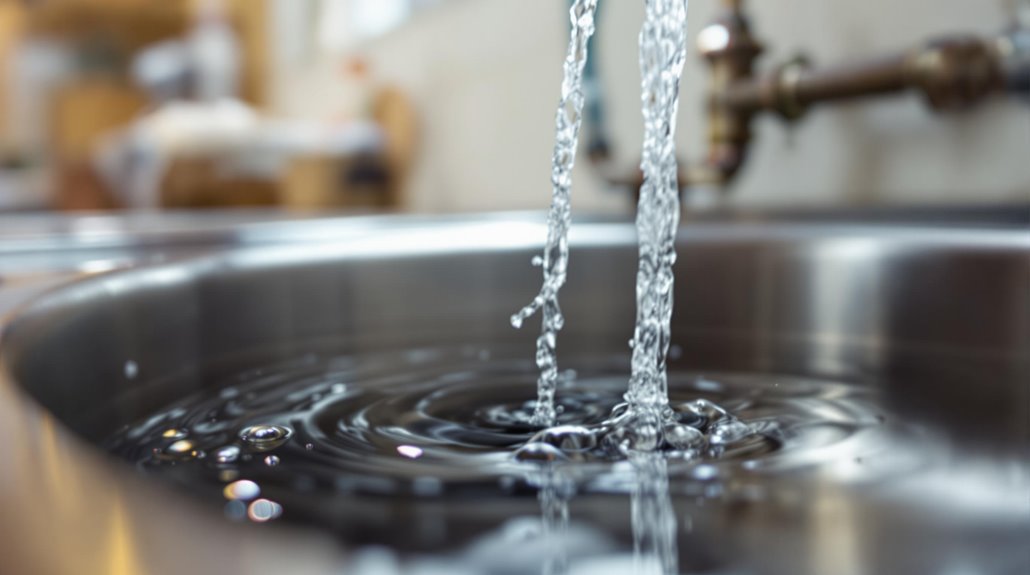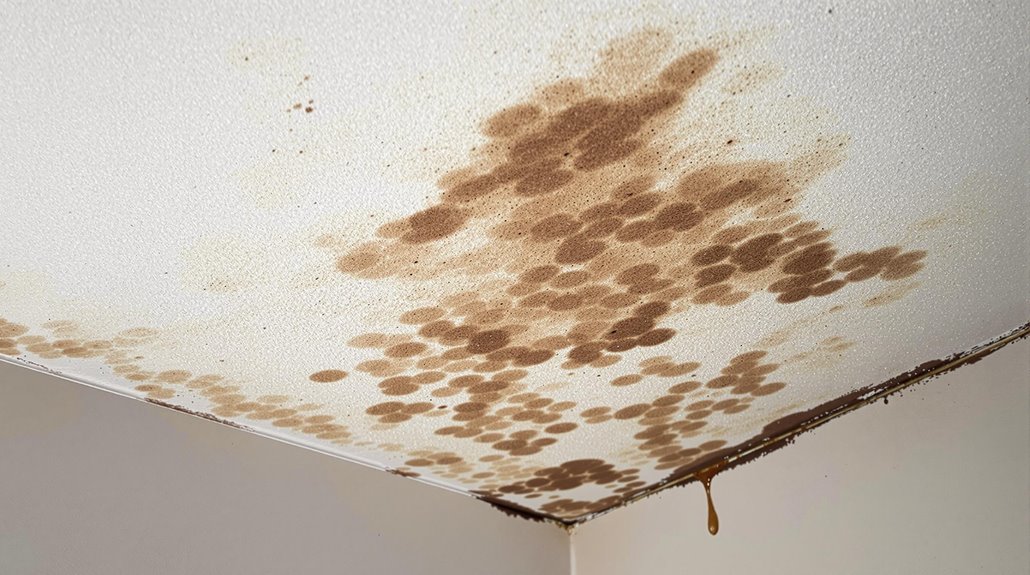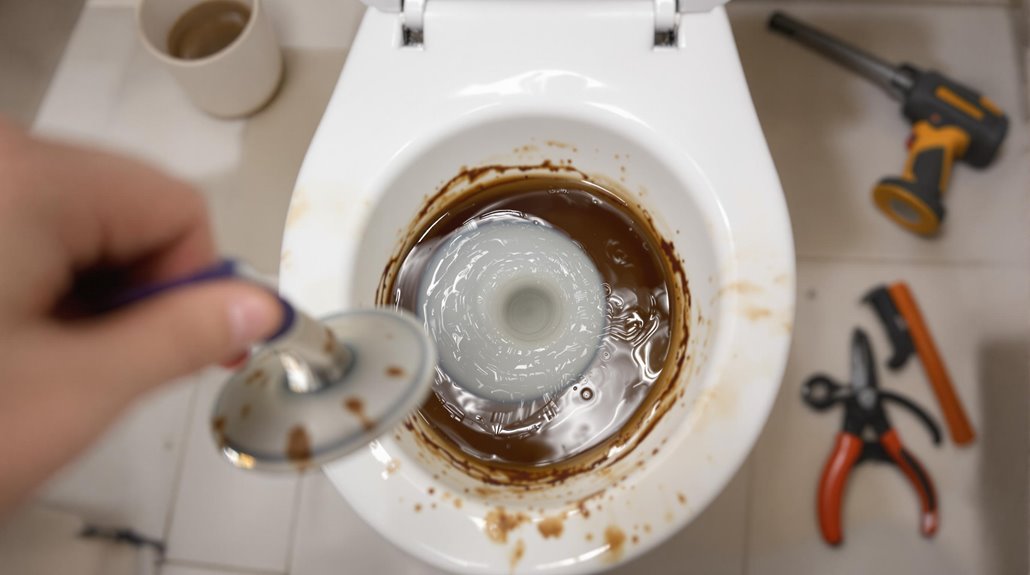To spot a plumbing emergency, watch for several key indicators. Unusual pipe noises, like gurgling or banging, suggest underlying issues. A sudden drop in water pressure can signal potential failures, while discolored water points to contamination. Look for damp spots on walls or ceilings, which can indicate leaks. If you notice persistent clogs or foul odors from drains, take action immediately to prevent worsening problems. Regular maintenance is crucial to spot emerging issues early. Being aware of these signs can help you respond effectively. Uncovering more about each indicator will improve your ability to manage plumbing emergencies effectively.
Key Takeaways
- Unusual pipe noises, like gurgling or banging, can indicate serious plumbing issues that need further investigation.
- Rapid water accumulation or unexpected drops in water pressure signal potential leaks or plumbing failures requiring immediate attention.
- Discolored water may indicate contamination or damaged pipes, necessitating urgent inspection and repair.
- Persistent unpleasant odors or visible damp spots suggest hidden leaks that could lead to mold growth and other problems.
- If you experience sewage backups or burst pipes, seek professional help immediately to prevent extensive damage and health hazards.
Common Signs of Emergencies

How can you tell if you're facing a plumbing emergency? Look for clear indicators that require immediate attention. Unusual noises from pipes, such as banging or gurgling, often signal underlying issues. Furthermore, rapid water accumulation under sinks or around appliances suggests a leak that needs prompt action. You might likewise notice water pressure drops or discolored water, both of which indicate potential plumbing failures. To avoid these situations, regular preventive maintenance is crucial; it helps identify problems before they escalate. Having a plan for emergency preparedness can save you time and money in urgent situations. By staying vigilant and addressing these common signs, you can effectively manage plumbing emergencies and maintain a safe, functional home environment. Additionally, contacting an emergency plumber right away can help mitigate further damage and restore your plumbing system efficiently.
Identifying Water Leaks
While you might not always see water pooling on the floor, identifying leaks in your plumbing system is essential for preventing extensive damage. Effective leak detection involves regularly checking for signs of moisture and evaluating your home's plumbing integrity. Here are some indicators to watch for:
- Unexplained water bills
- Damp spots on walls or ceilings
- Mold growth in hidden areas
- Foul odors from dampness
- A musty smell in your home
Conducting a thorough moisture evaluation can help you pinpoint hidden leaks before they escalate. Look for discoloration or soft spots in materials, which may indicate water intrusion. By staying vigilant, you can address leaks early and protect your property from costly repairs. Additionally, it's crucial to have access to expert water damage restoration services to manage any issues effectively.
Recognizing Gurgling Sounds

Gurgling sounds in your plumbing can signal serious issues within your system. These gurgling noises often indicate that air is trapped in the pipes, usually because of a blockage or venting problem. When you hear these sounds, it's crucial to pay attention as they can be early plumbing symptoms of a more significant issue, such as a clogged drain or a malfunctioning sewer line. Ignoring these noises can lead to further complications, including water damage or sewage backup. To address this concern, observe when the sounds occur—after flushing a toilet or running water. If you frequently hear gurgling, it's advisable to consult a plumbing professional who can diagnose and resolve the underlying problems effectively.
Dealing With Clogged Drains
Clogged drains can quickly escalate from a minor inconvenience to a plumbing emergency if not addressed promptly. To prevent this, regular drain cleaning and preventive maintenance are vital. Here are some signs that you might have a clog forming:
- Slow drainage in sinks or tubs
- Unpleasant odors emanating from drains
- Frequent gurgling sounds
- Water pooling around fixtures
- Overflowing toilets
If you notice any of these symptoms, it's important to act quickly. Start with a plunger or a plumbing snake to clear minor clogs. For persistent issues, consider professional drain cleaning services. Being proactive can save you from costly repairs and extensive damage, ensuring your plumbing system runs smoothly and efficiently.
Assessing Water Stains

Water stains on ceilings, walls, or floors can be a clear indicator of a plumbing issue that needs immediate attention. Conducting a thorough stain inspection helps you identify potential water damage before it escalates. Here's a table to help you assess the stains:
| Stain Color | Possible Cause | Action Required |
|---|---|---|
| Yellowish-Brown | Leaking roof or pipes | Inspect and repair leaks |
| Dark Brown | Long-term water exposure | Consult a plumber |
| Greenish | Mold growth from moisture | Address dampness issues |
| Rusty Red | Corroded pipes | Replace affected pipes |
| Clear Water Stain | Recent leak | Dry area and monitor |
Monitoring Water Pressure
After addressing any visible water stains, it's important to keep an eye on your water pressure. Monitoring water pressure can help you identify potential plumbing emergencies before they escalate. You can use a pressure gauge to measure the water pressure in your home. Ideally, water pressure should range between 40 to 60 psi.
Here are some signs to watch for:
- Fluctuating water pressure during use
- Unusually high or low pressure readings
- Dripping faucets or leaking pipes
- Frequent clogs in drains
- Noisy pipes when water is running
If you notice any of these issues, consider consulting a plumber. Regularly checking your water pressure can save you from costly repairs and guarantee your plumbing system functions efficiently.
Responding to Toilet Issues

Toilet issues can disrupt your daily routine and often signal a plumbing emergency that requires immediate attention. When you encounter toilet malfunctions, such as frequent clogs, continuous running water, or overflowing, it's essential to act swiftly. Start by shutting off the toilet's water supply to prevent further damage. If the toilet overflows, use towels or a mop to contain the water and minimize mess. For persistent clogs, try a plunger or a toilet auger, but avoid chemical drain cleaners as they can damage plumbing. If these measures don't resolve the issue quickly, emergency repairs may be necessary. Always monitor for signs of leaks or water pooling around the base, as these can indicate more serious underlying problems.
When to Call a Professional
When should you call a professional for plumbing issues? It's crucial to recognize situations that demand immediate attention and a professional assessment. Don't hesitate to contact emergency services if you encounter any of the following:
- A significant water leak that you can't control
- Persistent clogging that resists conventional methods
- Sewage backup causing health hazards
- Burst pipes leading to extensive water damage
- Unusual noises from pipes indicating potential failure
These issues can escalate quickly, resulting in costly repairs and safety risks. A professional can provide a thorough inspection and effective solutions, ensuring your plumbing system functions correctly. Trust your instincts—when in doubt, it's better to call a professional than to risk further damage.
Conclusion
In conclusion, spotting a plumbing emergency early can save you time, money, and stress. By watching for leaks, listening for gurgles, addressing clogs, observing stains, checking pressure, and responding to toilet troubles, you empower yourself to take action. Remember, knowing when to call a professional is just as important as diagnosing the problem. Stay vigilant, stay informed, and don't hesitate to reach out for help when needed. Your home deserves prompt and effective plumbing care.
